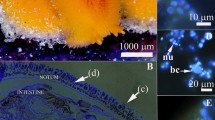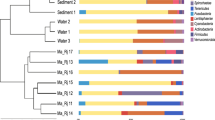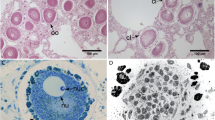Abstract
THE large, morphologically peculiar microorganism Epulopiscium fishelsoni1,2 inhabits the intestinal tract of Acanthurus nigrofuscus, a brown surgeon fish (family Acanthuridae) from the Red Sea. Similar microorganisms have been found in surgeonfish species from the Great Barrier Reef3. As these microorganisms have only been seen in surgeonfish and no free-living forms have been found, they are considered to be specific symbionts of surgeonfish, although the nature of the symbiosis is unclear1–4. Initial reports considered them to be eukaryotic protists, based primarily on their size1–4, with individuals being larger than 600 μm by 80 μm. But their cellular morphology in the electron microscope is more like that of bacterial than eukaryotic cells1,2,54. To resolve the nature of these symbionts, we have isolated the genes encoding the small subunit ribosomal RNA from two morphotypes and used them in a phylogenetic analysis. In situ hybridization with oligonucleotide probes based on the cloned rRNA sequences confirmed the source of the rRNA genes. Our results identify the symbionts as members of the low-(G + C) Gram-positive group of bacteria. They are therefore the largest bacteria to be described so far.
This is a preview of subscription content, access via your institution
Access options
Subscribe to this journal
Receive 51 print issues and online access
$199.00 per year
only $3.90 per issue
Buy this article
- Purchase on Springer Link
- Instant access to full article PDF
Prices may be subject to local taxes which are calculated during checkout
Similar content being viewed by others
References
Fishelsen, L. Montgomery, W. L. & Myrberg, A. A. Jr Science 229, 49–51 (1985).
Montgomery, W. L. & Pollak, P. E. J. Protozool. 35, 565–569 (1988).
Clements, K. D., Sutton, D. C. & Choat, J. H. Mar. Biol. 102, 403–412 (1989).
Montgomery, W. L. & Pollak, P. E. Mar. Ecol. Prog. Ser. 44, 7–13 (1988).
Clements, K. D. & Bullivant, S. J. Bact. 173, 5359–5362 (1991).
Saiki, R. K. et al. Science 239, 487–491 (1988).
Olsen, G. J. et al. Nucleic Acids Res. 20, 2199–2200 (1992).
Olsen, G. J. Meth. Enzym. 164, 793–812 (1988).
Woese, C. R. Microbiol. Rev. 51, 221–271 (1987).
Felsenstein, J. Evolution 37, 783–791 (1985).
DeLong, E. F., Wickham, G. S. & Pace, N. R. Science 243, 1360–1363 (1989).
Woese, C. R., Kandler, O. & Wheelis, M. L. Proc. natn. Acad. Sci. U.S.A. 87, 4576–4579 (1990).
Blakemore, R. P. & Canale-Parola, E. Arch. Mikrobiol. 89, 273–289 (1973).
Delaporte, B. Ann. Inst. Pasteur, Paris 107, 246–262 (1964).
Starr, M. P. & Schmidt, J. M. in The Prokaryotes (eds Starr, M. P., Stolp, H. Trüper, H. G., Balows, A. & Schlegel, H. G.) 3–42 (Springer, New York, 1981).
Jannasch, H. W., Nelson, D. C. & Wirsen, C. O. Nature 342, 834–836 (1989).
Ward, D. M., Bateson, M. M., Weller, R. & Ruff-Roberts, A. L. in Advances in Microbial Ecology (ed. Marshall, K. C.) Vol. 12 219–286 (Plenum, New York, 1992).
Sambrook, J., Fritsch, E. F. & Maniatis, T. Molecular Cloning: A Laboratory Manual 2nd edn (Cold Spring Harbor Laboratory, New York, 1989).
Biggin, M. D., Gibson, T. J. & Hong, G. F. Proc. natn. Acad. Sci. U.S.A. 80, 3963–3965 (1983).
Author information
Authors and Affiliations
Rights and permissions
About this article
Cite this article
Angert, E., Clements, K. & Pace, N. The largest bacterium. Nature 362, 239–241 (1993). https://doi.org/10.1038/362239a0
Received:
Accepted:
Issue Date:
DOI: https://doi.org/10.1038/362239a0
This article is cited by
-
Patatin-like phospholipase CapV in Escherichia coli - morphological and physiological effects of one amino acid substitution
npj Biofilms and Microbiomes (2022)
-
The functional roles of surgeonfishes on coral reefs: past, present and future
Reviews in Fish Biology and Fisheries (2022)
-
Recombination contributes to population diversification in the polyploid intestinal symbiont Epulopiscium sp. type B
The ISME Journal (2019)
-
The chromosome copy number of the hyperthermophilic archaeon Thermococcus kodakarensis KOD1
Extremophiles (2015)
Comments
By submitting a comment you agree to abide by our Terms and Community Guidelines. If you find something abusive or that does not comply with our terms or guidelines please flag it as inappropriate.



